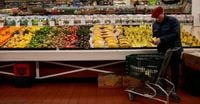American shoppers are facing a grocery crisis unlike anything in recent memory, with prices for everyday food staples—especially beef and vegetables—soaring to historic highs. Just months after President Trump’s return to the White House on promises to slash grocery bills, consumers across the country are expressing outrage and disbelief as sticker shock grips supermarket aisles. Receipts shared on social media show premium beef cuts topping $50 per pound and even standard beef nearing $20 per pound, a reality that has turned steak dinners into a rare luxury for many families. Meanwhile, vegetable prices have spiked by a staggering 38% since the start of the year, adding to the financial strain on American households.
So, what’s driving these eye-watering increases? According to the U.S. Department of Agriculture and numerous economic analysts, it’s a perfect storm of policy decisions, climate impacts, and persistent supply chain woes. At the heart of the controversy is President Trump’s aggressive trade war, which has seen tariffs on food imports—especially a 50% tariff on Brazilian beef—implemented in early 2025. This move, intended to protect domestic ranchers and address trade imbalances, has instead slashed competition and tightened supply, pushing prices upward for consumers. As the USDA Cattle Inventory Report from July 2025 revealed, the U.S. cattle count has plummeted to its lowest level since 1951, a direct result of years of severe drought in major grazing states like Texas and Kansas. These environmental factors have forced ranchers to reduce their herds dramatically, further constricting the beef supply chain.
It’s not just beef that’s been hit. Vegetable prices have also surged, with tariffs on imports like tomatoes, asparagus, cauliflower, and cucumbers contributing to the spike. Economist David Ortega told Marketplace that these tariffs, combined with other factors, are "limiting overall supply … [and] can cause homegrown veggie prices to rise too." But tariffs are only one piece of the puzzle. According to ABC News, analysts point to a combination of adverse weather, ongoing supply chain disruptions, and a labor crisis in agriculture as key contributors to the rising cost of produce.
The labor shortage, in particular, has been exacerbated by Trump’s ongoing deportation policies. Phil Kafarakis, president of the Chicago-based IFMA The Food Away from Home Association, explained to NBC News that "not enough laborers in the fields to pick up and collect product as it's coming to harvest" has become a critical issue. Robert Lynch, an economics professor and co-author of a recent report on immigrant workers in the U.S., noted that agricultural employment dropped by 6.5% between March and July 2025—after increasing during the same periods for the last two years. The causes? Deportations, fewer new immigrants being allowed into the country, and fear of government raids among those who remain. "American workers are not stepping in to fill those employment gaps," NBC News added, leaving crops unharvested and prices higher for everyone.
All these factors have converged to create what one social media user, @aintscarylarry, described as a crisis: "Beef: 18 bucks a pound… We are in some deep, deep shit, people." Photos of ribeye steaks priced at $54.99 per pound in New York and ground beef near $22 per pound elsewhere have gone viral, fueling public anger and frustration. According to the Consumer Price Index as of mid-2025, the cost of eggs is up 16.4%, coffee by 14.5%, and uncooked ground beef by 11.5%. Pew Research reports that 69% of Americans now find it harder to eat healthy due to rising food prices, with lower-income adults suffering the most.
President Trump’s campaign pledges are now under intense scrutiny. Throughout 2024, he assured voters, "When I win, I will immediately bring prices down," and later claimed, "I won on groceries… We’re going to bring those prices way down." Yet, since taking office, the opposite has occurred. MAGA supporters argue that inflationary trends began under the previous administration, but the timing of the beef and vegetable price surges aligns closely with Trump’s new tariffs and immigration enforcement policies. The White House has begun shifting its messaging, with officials suggesting that Americans consider cheaper proteins or reduce meat consumption—a far cry from the campaign’s bold promises.
For many, these reassurances ring hollow. The administration’s advice to "switch meats" or buy less beef ignores the core affordability crisis facing millions of households, where protein choices are dictated by strict budgets. Reversing the tariffs could spark political backlash, and rebuilding cattle herds will take years—especially with climate volatility continuing to threaten feed supplies and grazing land. Meanwhile, the labor shortage in agriculture shows no sign of abating, as American workers remain reluctant to fill the jobs vacated by deported immigrants.
Experts agree that there’s no single culprit for the grocery price explosion. As ABC News summarized, "experts can’t pin the rise in wholesale vegetable costs on any one culprit, with tariffs, deportations, inclement weather, issues with the supply chains or other factors all possible contributors." However, the cumulative effect is undeniable: food inflation is squeezing Americans from all sides, and the path to relief remains uncertain.
In the meantime, food experts and consumer advocates are offering practical strategies to help families cope. Phil Lempert, the so-called "Supermarket Guru," advises Americans to "take inventory before you go shopping," avoid overbuying and overcooking, and buy in-season and frozen produce. Shopping at local growers and farmers’ markets, taking advantage of store sales, and even planting a home garden are other ways to stretch grocery budgets. The Chef & The Dish recommends skipping pre-cut produce, which "is so much more expensive and filled with preservatives," and instead chopping your own to save money and improve freshness. Meal planning, buying in bulk, and joining grocery store loyalty programs can also help mitigate the impact of rising prices.
Despite these tips, the reality for many is that even the most careful planning can’t fully offset the dramatic increases in staple food prices. As tariffs take full effect and herds remain depleted, relief seems distant. For now, the sizzle has gone out of the American steakhouse experience for many, replaced by budget anxiety and political frustration. The rising cost of groceries has become a potent symbol of broken economic promises and household strain, leaving consumers to wonder when—or if—things will get better.
As the nation grapples with these challenges, the debate over tariffs, immigration, and climate resilience in agriculture will remain front and center, shaping both kitchen tables and the political landscape for months to come.




